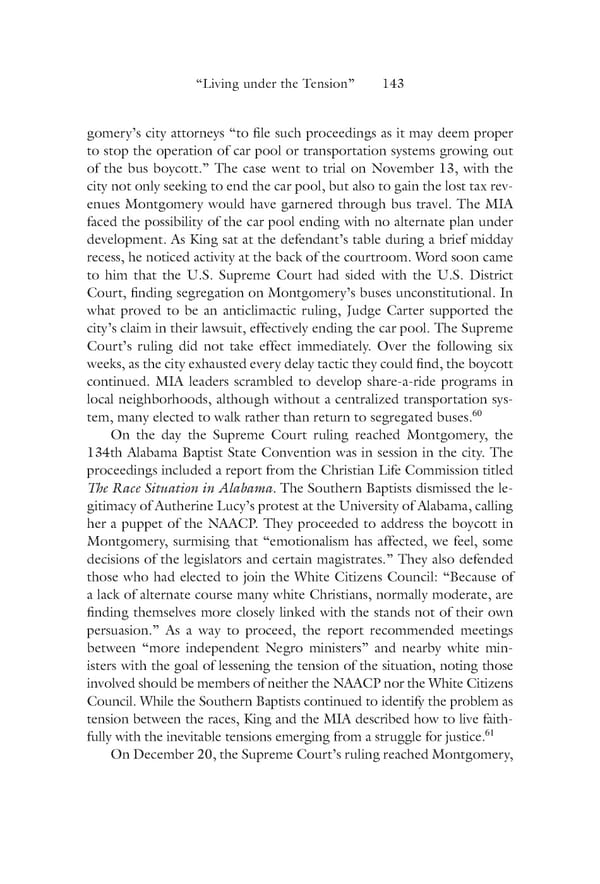“Living under the Tension” 143 gomery’s city attorneys “to file such proceedings as it may deem proper to stop the operation of car pool or transportation systems growing out of the bus boycott.” The case went to trial on November 13, with the city not only seeking to end the car pool, but also to gain the lost tax rev- enues Montgomery would have garnered through bus travel. The MIA faced the possibility of the car pool ending with no alternate plan under development. As King sat at the defendant’s table during a brief midday recess, he noticed activity at the back of the courtroom. Word soon came to him that the U.S. Supreme Court had sided with the U.S. District Court, finding segregation on Montgomery’s buses unconstitutional. In what proved to be an anticlimactic ruling, Judge Carter supported the city’s claim in their lawsuit, effectively ending the car pool. The Supreme Court’s ruling did not take effect immediately. Over the following six weeks, as the city exhausted every delay tactic they could find, the boycott continued. MIA leaders scrambled to develop share-a-ride programs in local neighborhoods, although without a centralized transportation sys- 60 tem, many elected to walk rather than return to segregated buses. On the day the Supreme Court ruling reached Montgomery, the 134th Alabama Baptist State Convention was in session in the city. The proceedings included a report from the Christian Life Commission titled The Race Situation in Alabama. The Southern Baptists dismissed the le- gitimacy of Autherine Lucy’s protest at the University of Alabama, calling her a puppet of the NAACP. They proceeded to address the boycott in Montgomery, surmising that “emotionalism has affected, we feel, some decisions of the legislators and certain magistrates.” They also defended those who had elected to join the White Citizens Council: “Because of a lack of alternate course many white Christians, normally moderate, are finding themselves more closely linked with the stands not of their own persuasion.” As a way to proceed, the report recommended meetings between “more independent Negro ministers” and nearby white min- isters with the goal of lessening the tension of the situation, noting those involved should be members of neither the NAACP nor the White Citizens Council. While the Southern Baptists continued to identify the problem as tension between the races, King and the MIA described how to live faith- 61 fully with the inevitable tensions emerging from a struggle for justice. On December 20, the Supreme Court’s ruling reached Montgomery,
 Becoming King: Martin Luther King Jr. Page 163 Page 165
Becoming King: Martin Luther King Jr. Page 163 Page 165